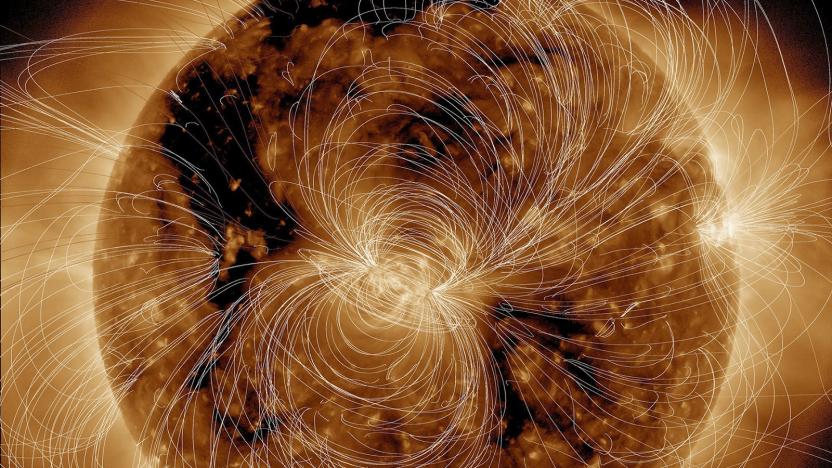Magnetosphere
Latest

Just another day in our Sun's crazy magnetic life
Sunspots, flares and other solar activity show the sun's wild side, but we never see the massive forces that cause them. Now, scientists from NASA's Solar Dynamics Observatory (SDO) have created a visualization of the powerful magnetic fields that create havoc on the solar surface. They overlaid a computer-generated magnetic field onto a live image from August 16th, giving us a fuller picture of the sun's power and menace.

Some of Earth's oxygen escapes to the moon every month
The Earth and the moon share more than an orbit around the Sun. Turns out that bits of atmosphere manage to travel the 240,000 miles out to our nearest celestial neighbor, and have been for more than 2 billion years, according to data gathered by Japan's moon-orbiting Kaguya spacecraft.

NASA flies four satellites in 'tightest ever' formation
NASA is boasting that it's been able to fly four giant satellites around our home in the "tightest" formation ever attempted in space. The quartet of craft are just six miles apart, and comprise the Magnetospheric Multiscale Mission, a project to measure Earth's magnetic fields as they swirl around us. In order to fully understand how the magnetosphere works in three-dimensional space, the satellites had to be guided to fly in the shape of a four-sided pyramid. Now, if you're struggling to see why this is such a big deal, remember that each satellite is the size of a baseball field and each one is hurtling through the abyss at 15,000 miles per hour.

Watch NASA launch its mission to the magnetosphere tonight (update)
If all goes well, NASA will finally launch its Magnetospheric Multiscale (MMS) observatories tonight. Comprised of four identical spacecraft (shown above in a clean room), its purpose is to study the magnetic fields around Earth for information on how they connect and disconnect. The MMS is headed to areas that scientists believe are the sites where magnetic reconnection occurs, but first it has to get off the ground. The launch is scheduled for 10:44PM ET at Cape Canaveral Air Force Station, and all conditions are go. You can watch live on NASA TV, and a stream is embedded after the break. Update: The launch was successful and the mission is on its way, check after the break for a replay and to see more information on exactly what its satellites will be studying.

Spaceship "force field" could protect astronauts on trip to Mars
While there's certainly no shortage of folks working on sending robots to Mars, there's also thankfully a few researchers focusing on making the trip a bit more bearable (and survivable) for us humans, and a group from a consortium of different institutions now say they've made some real progress on that front. Their idea is to use a portable "mini-magnetosphere," which would protect a spacecraft from harmful solar storms and cosmic rays in much the same way the Earth's magnetosphere naturally protects the planet. That is actually an idea that has been around for decades, and was shown last year to be at least theoretically possible, but it has only now been taken beyond the realm of computer simulations. That was apparently possible thanks to the use of an unspecified "apparatus originally built to work on fusion," which allowed researchers to recreate "a tiny piece of the Solar Wind" and confirm that a small "hole" in the wind would indeed be all that would d be necessary to keep astronauts safe. Of course, the leap from the lab to an actual spacecraft is another matter entirely, but the researchers seem to think that there's quite a bit of promise in the idea.[Via PhysOrg, image courtesy of NASA]

Splash that iTunes visualizer across multiple monitors
iPodHacks has a very easy way to display your iTunes visualizer across multiple monitors using Mac OS X's built-in accessibility zoom feature. The instructions show you how to enable Zoom in the Universal Access system preference pane. When the visualizer is playing, you can zoom in on the iTunes window, and the image of the window is spread across all your screens. The quality of the zoom, of course, is a bicubic interpolation of the screen image, so it's not as crisp as it could be. Also, the fluidity of the display depends greatly on how powerful your video card is, and how it's connected to your computer. Multiple video cards also don't necessarily help, unlike with the original Magnetosphere visualizer. For a party, though, it's a neat trick. If you have other ways to make this happen, feel free to leave a comment!

Star Trek-style deflector shield to fend off harmful radiation
When you've got folks dreaming up such things as a $2.5 trillion "space sunshade," we reckon a Star Trek-style deflector shield isn't too far-fetched. Apparently, a team of British scientists are looking into the possibility of crafting such a device in order to " protect astronauts from radiation" when they venture beyond the Earth's protective magnetic envelope, or "magnetosphere." Reportedly, the team is hoping to "to mimic the magnetic field which protects the Earth" and deploy the shields "around spacecraft and on the surfaces of planets to deflect harmful energetic particles." As nation's begin to revive plans of space exploration, the homegrown shield should look mighty attractive at the Royal Astronomical Society's National Astronomy Meeting, but details concerning a proposed launch date, and moreover, the presumably lofty pricetag, have yet to emerge.[Via Slashdot]





